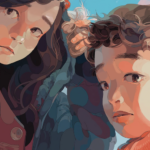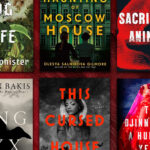How to Run Storytime Without Boring Everyone to Death
(Or Suffering a Nervous Breakdown)
For eight years I worked Storytime at a public library. When I mention this to people I get very mixed reactions. Sometimes, they’re impressed. They’ll ask about the crafts and the kids; they tell me it sounds like a rewarding experience. Others get a look on their face like they bit into a raw onion. Oh, they’ll reply, grimacing. How was that?
I mean, I get it. It’s a tough gig. I have to say, it’s easier looking back at Storytime with a sweet sense of nostalgia than when I was doing the actual work, peeling dried Elmer’s glue off my only good work pants and singing Raffi at nine in the morning to a bevy of screaming toddlers. Working children’s services sometimes means dealing with a bunch of sugared-up kids who got into a box of Lucky Charms cereal (I recognize that look—I also eat Lucky Charms to get amped). But it also means thinking on your feet and getting way outside your comfort zone. By that I mean you’ll probably have to kneel on the floor, and if you’re wearing a skirt, everyone is gonna see your underwear and four different kids will point it out loud enough for everyone in the library to hear.
When it comes to children’s programming, you quickly learn what will fly and what’s going to completely bomb. Most things don’t go over so hot. The notion of sitting in a rocking chair while a bunch of dimple-cheeked kids rest quietly at your feet is a lovely dream, but the odds are they will have already heard the book you’re reading, and they’ll decide it would be a cooler time to get up and play a game of tag or throw crayons at each other. When I first began planning Storytime programs, I chose books with beautifully detailed pictures and sweet plots about baby animals. This backfired spectacularly.
You don’t know how long a page can drag on until you hear a kid in the front row yell “I’m BORED” at the top of their lungs when you’re one paragraph into a 25 page book. You start speed reading. You’ve never read so fast in your entire life. Is the book funny? Is the story compelling i.e. does it talk about garbage or something gross? Does it involve using the bathroom? You’d better pray it does.
I learned a lot about creativity by dealing with kids who were difficult to please. It forced me to think outside the box, and I mean that literally—we did puppet shows on a shit budget, where I turned a refrigerator box into a stage and created puppets from old stuffed animals by pulling out their insides and jabbing popsicle sticks inside their floppy limbs. It makes you think fast. It’s hard work, and it’s definitely not for everyone.
Parents bring their kids to Storytime for several reasons: they’re trying to get out of the house, they genuinely like the programming, and they want to spend time with other parents who’ve got the same deer-in-headlights look. It’s an opportunity for them to commiserate and make friends.
On those rare occasions when everything came together, the Storytime programs I ran allowed everyone to unwind and enjoy themselves—including the parents. I told stories that were a mix of new and old, ramping up the nostalgia so parents could go home and try it out for themselves. I made a flannel board of “10 Little Monkeys” where the doctor was David Tennant, and one dad laughed at that every damn week. Connecting with a multi-generational audience meant thinking broadly and trying out really weird stuff: like crossover events where Pet Shop Boys and Frank Sinatra were the background music to finger plays and puppet shows.
Sometimes these mashups didn’t work, but a lot of times they did. When a mom cried after her kid made her a bouquet of egg carton roses for mother’s day during one of my programs, I teared up, too. It was cool to see something work, to see it affect others positively. (Don’t tell anyone I cried).
And the creativity that Storytime required flooded other areas of my library work. I brought it to circulation: getting rid of the dusty, outdated pamphlets everyone ignored and creating program bookmarks to slip inside checked out materials. I also planned “giveaways” of stuff we never used, effectively cleaning house while making patrons happy because they got free stuff (patrons love freebies). My work with the kids helped when it came to dealing with dwindling budgets and answering truly bizarre reference questions, and it allowed me the patience to deal with patrons who acted like babies when they were told they’d have to pay their fines before they could check out that DVD of Mrs. Doubtfire. It provided insight into dealing with grumpy coworkers and with frustrated employees.
It also helped me shape our collection through selecting more relevant materials, items that stimulated a wider degree of interest, and it helped me visualize how I could make the library more inviting to patrons. Make it more inviting to ME. Most of all, it allowed me to start using a lot more glitter. The parents hated this, it got all over everything, but the kids loved it and you know what, I fucking loved it, too. I love glitter. Let me live, okay? Storytime showed me it was okay to be silly about things. It’s alright to be dumb and truly enjoy it.
Working Storytime even helped my writing. I’d read my work aloud and really listen to it, asking myself: “Is this boring someone? Is it boring me?” Would it hold the attention span of a 5-year-old, or would they start screaming and somersaulting on the rug? Most of the time, it would not—but my work definitely improved by asking the question.
I can also clean cookie guts out of anything now. And that is a truly priceless life skill.




















